




























Hello, Eco Kids, and welcome to your ‘Winter Wildlife’ edition of the magazine!
Are you thinking I look a little familiar…?
You’d be right! I’m a snowy owl – just like Harry Potter’s owl, Hedwig!



Thanks to being a bit ‘magical’, we snowy owls are also famous. Did you know that in Europe there are cave paintings of us that date back 30,000 years ago? Seems that humans have always thought we were pretty cool!
Oh, I do LOVE the winter! I’m so well adapted, you see. Look at my fluffy feet! Don’t be alarmed by my enormously sharp beak and talons – they’re just perfect for scooping up my favourite food: lemmings. After breeding in the Arctic tundra, we all follow these YUMMY critters north. I eat three to five of them every day – that’s a whopping 1,600 per year! No wonder snowies are the heaviest owls in North America! Actually, it’s not fat – it’s FEATHERS. We’re VERY well insulated.
Do you like my plumage? So snowy white – hence the name! Being female, I have darts of dark brown, too. (Males are plain white.) Camouflage is crucial, because unlike other owls, we hunt during the day, as well as at night
I get slightly darker in the spring and summer, but don’t change nearly as much as some animals (see pages 10-11). The thing is, snowy owls might need to adapt MORE in the future. Less snow, you see. Thanks a bunch, climate change
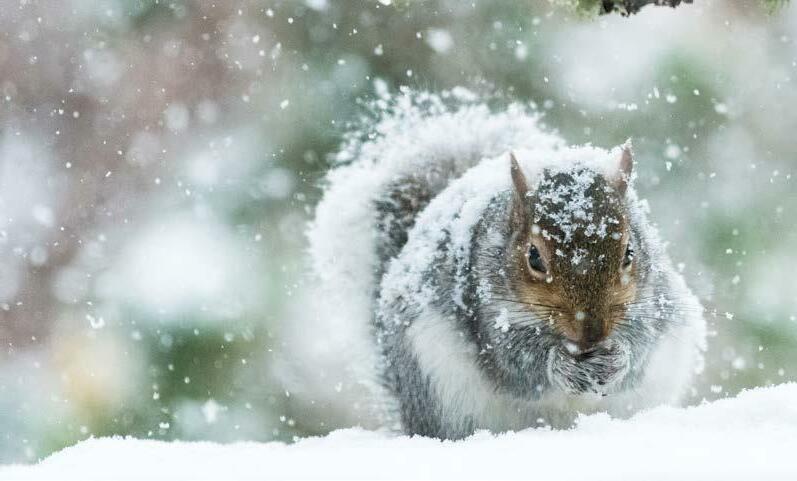
Brrr-ds!
Winter is a great time to see birds. They don’t all leave for warmer places – and lots of birds visit from abroad in the winter months. Many familiar birds that visit British gardens are from parts of Europe that are even colder! Rarely seen birds often come with them.
When the trees lose their leaves, it’s easier than ever to see nests in the bare branches. Birds are easier to see, too, and some travel in great flocks looking for food. Short-eared owls are most widely seen in winter – they often hunt in daylight. And one of the most spectacular sights is the swirling skydance of starlings!
Many starlings visit Britain from mainland Europe in winter. At dusk, thousands take to the skies to create a twisting, turning mass. They swoop, dive and perform stunts before roosting for the night. It’s called a murmuration. Maybe it’s to put off predators – or to attract other starlings so they can all roost together. But how do they all know when to turn without crashing into each other? We’re not sure!
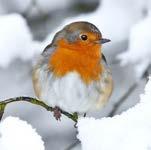
No, they appear on Christmas cards, but they’re actually around all year, including spring and summer! When there’s more food about, they search for it in the woods, where they’re harder to see. They have red breasts all year, too, except for the youngest robins. They also defend their territories throughout the year, fighting and even killing their rivals! They’re tougher than they look!
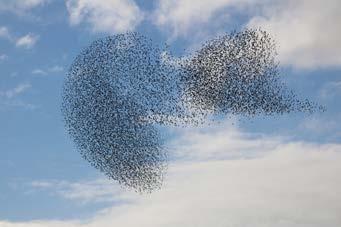
Roosting: Settling down to rest or sleep.
Is winter the worst time to see wildlife, when so many creatures migrate, hibernate or hide away? No, there’s still plenty of…
A walk in the woods is great in winter. The woods may seem still and silent but there’s plenty to see. The trees look amazing and still host lots of life, from squirrels and birds to fungi.
There’s lots of weird, wonderful, colourful fungi about. Yellow brain is a goldenyellow jelly fungus mainly seen on dead branches in the winter months. And
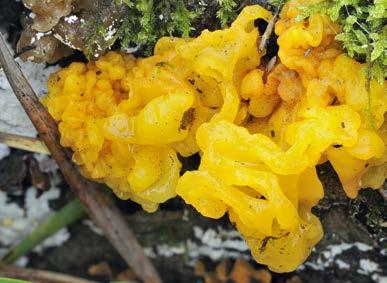
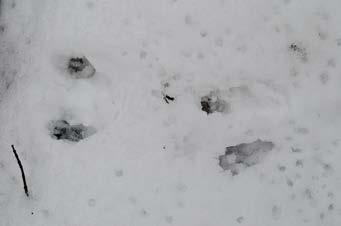


Wherever you live, if it’s snowy or frosty, you can look for animal tracks and try to work out which creature left them. You
scarlet elf cups really do look as though elves could drink out of them! See what strange winter fungi you can find.
Grey squirrels mate between January and April, and are usually about. Red squirrels stay active, too, although they’re much rarer. Red foxes are also out looking for mates. The females (vixens) give chilling screams as a mating call. You’d think that would scare the males away!
can also guess whether it was running, or even being chased – and if it got away! Remember, both paws and tails can leave tracks.
A. B.
Surprising
Ever wondered what happens to some of the smallest creatures when it gets cold, frosty and snowy? We sent Charlie, the Eco Kid who can talk to animals, to ask them! Here’s what they said…
Charlie: Miss Ladybird, what will you and your friends do in winter?
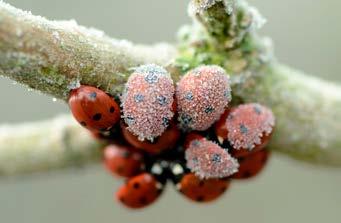
Ladybird: We’ll huddle together to keep warm, maybe in a tree or even in your house, Charlie! Then we’ll go into a state where we hardly do anything – not even move.
Charlie: Mr Red Admiral Butterfly, what will you do in winter?

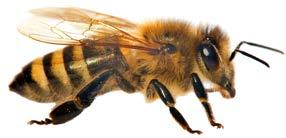

Red Admiral Butterfly: I slow right down like I’m in a deep sleep, too. You might see me hanging upside down in your dad’s shed!
Charlie: Mr Honeybee, got any plans for winter?
Honeybee: We all huddle together in our hive for winter. We live off the honey we’ve made and stored all year – eating it keeps us warm. That’s why we make it!
Charlie: Mr Silverfish, I usually see you running around in circles on my bathroom floor. What do you do in winter?
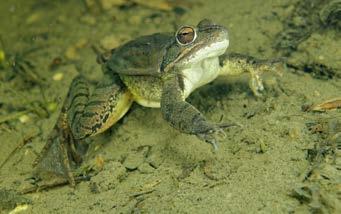

Silverfish: I can alter my blood to stop me freezing, so I don’t need a winter coat!
I can also go into a state where I’m not active at all. Impressive, eh?
Charlie: How about you, Mrs Frog?
Frog: Maybe I’ll rest in the mud at the bottom of your garden pond, where the frost can’t reach me!
The state that these insects go into is called diapause. They can slow down all their body functions and survive for weeks on their stored body fat, barely alive. They don't grow or develop while they're in this state.
A: Fox. B: Squirrel.
Do you miss summer’s greenery in winter?
There’s still plenty of green about if you know where to look!
Moss is a small flowerless plant that grows in clumps and does especially well in winter. It can even look like it’s glowing green against the season’s brown, grey and white colours. You’ll find it on the ground, and on walls and trees just about everywhere!
Rhona and Rusty shrank right down to walk through some moss…
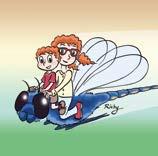

Rhona: You’re usually surrounded by mess, but I’ve never seen you surrounded by moss before, Rusty!
Rusty: This is like a walk in the jungle in summer. It’s as green as my cheeks after eating your cooking, Rhona!
Rhona: I’m a great cook, Rusty, and you know it! But, yes, I’d never noticed there were so many green plants around in winter.
Rusty: Why do people get rid of moss? It looks nice and doesn’t damage the things it grows on.
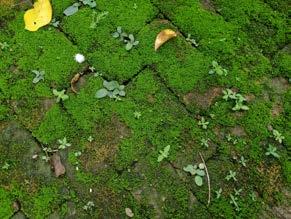
Rhona: No, but it does get slippery. Yee-ike! See, I nearly slipped. Moss loves wetness. That’s why it does so well outside of the dry, sunny months.
Rusty: It’s a pity we won’t see any animals here, like we do in a real jungle.
Rhona: We will. A moss piglet is heading this way!
Rusty: Yaagh! W-w-what’s a moss piglet?
Rhona: They’re also called tardigrades. They’re microscopic creatures with snouts like pigs. They love moisture, so they love living in moss.
Rusty: Are they d-d-dangerous?
Rhona: Sometimes they eat live organisms, so let’s stop moss-ing about and get back to normal size!
Don’t forget to go wildlife spotting this winter!
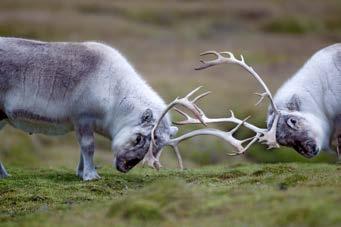
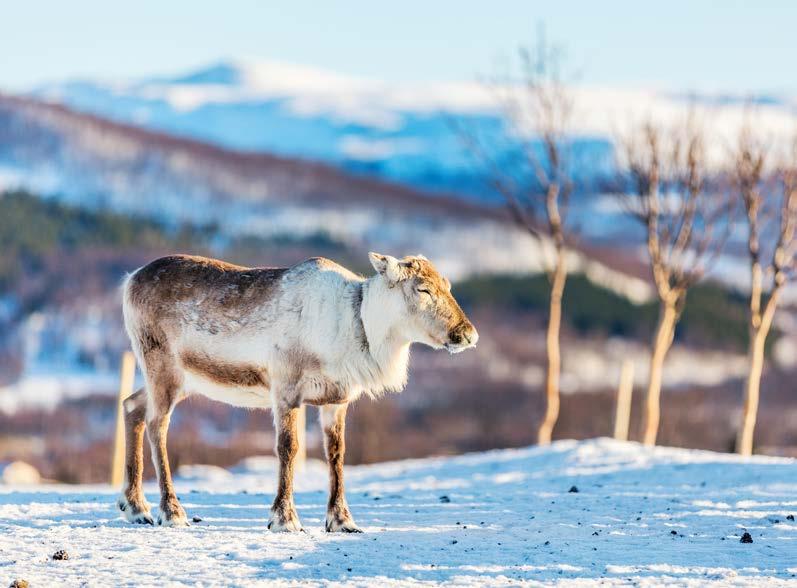
It’s me, Charlie, the Eco Kid who can talk to animals! It’s December, so I’m meeting a creature that makes you think of Christmas: a reindeer!
Charlie: I’m on an island somewhere between Norway and the North Pole. It’s Arctic weather here, so I’m glad I wrapped up warmly. I’ve found a reindeer! Wow, he’s huge, with a thick neck, big hooves and a large square nose. Reiner the Reindeer, is that you?
Reiner: Yes, it’s me, Charlie. I’ll come over.
Charlie: Your hooves make a great clicking sound when you walk!
Reiner: It’s handy, that. It helps us find each other in snowstorms!
Charlie: But I thought you’d have antlers.
Reiner: They dropped off. The rutting season’s over, so I don’t need them any more.
Charlie: What’s the rutting season?
Reiner: When we males compete for a mate and bash each other with our antlers!
Charlie: I definitely wouldn’t like to get bashed by r-r-reindeer antlers. S-s-sorry about my teeth chattering so much. How can you stand the cold here?
Reiner: My coat keeps me warm.
Charlie: But you’re not wearing one.
Reiner: I mean my natural coat – and I’m actually wearing two! See all these long, stiff hairs on my body?
Charlie: Oh, yes, and I remember now. I read that they’re hollow, which stops heat from moving and escaping too much.
© BlueOrangeStudio/Alamy Stock PhotoReiner: Well, I also have a softer underlayer, right next to my skin.
Charlie: I should have put two coats on, myself. You still have to breathe in all this f-f-freezing air, though.
Reiner: But I have a very talented nose. When I breathe in through it, it warms the air in less than a second. The air’s lovely and warm by the time it reaches my lungs.
Charlie: I wish my nose could do that! But the air you breathe out is cold. I can feel it. Brrr!
Reiner: Sorry about that, Charlie. Yes, I instantly cool the air I breathe out. It’s so I don’t lose much heat or moisture from my body.
Charlie: I had no i-deer you had all these skills! You’re very big, but is it true that some parts of you get smaller when it’s cold?
Reiner: Yes, my hooves! They shrink and tighten for a better grip on the icy ground. Harder, sharper hooves also help me paw through the snow and ice, so that I can get to the lichen I eat.


Charlie: They do have sharp-looking rims. And there’s hair between your toes.
Reiner: That stops them getting clogged with snow. My hooves expand again when the ground becomes soft and spongy in warmer weather.
Charlie: Is it true that your eyes change colour in winter, too?
Reiner: Yes, when I look into my friends’ eyes, they look gold in summer and blue in winter.
Charlie: They must adapt to the changing levels of light. Does climate change affect you at all here? Have you had any extreme weather?
Reiner: We’ve had some very heavy rainfall. When all that rainwater freezes, our food gets trapped under very thick ice. It’s hard for us to get at – impossible, sometimes. That’s a real problem for us.
Charlie: I bet it’s global warming that’s melting lots of ice. The melted ice evaporates, then it turns into those heavy rains.
Reiner: Well, I may be a reindeer but I definitely don’t like all that rain!
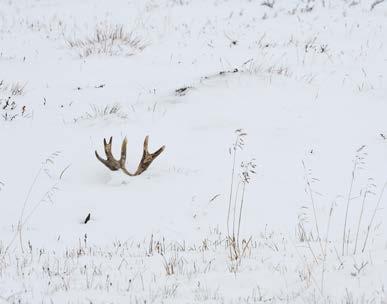
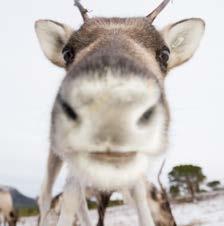
Don’t worry, it’s not a reindeer buried in snow. It’s just a pair of antlers that have been shed.
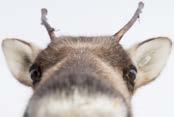
Reindeer are even more amazing than I thought – but I’ll be glad to get back somewhere warm!
It’s not really reindeer’s hooves that click. It’s tendons (body tissues) slipping over their foot bones when they walk.
Did you know that some creative creatures turn completely white in winter? Changing colour during the coldest season helps these ingenious animals to blend in brilliantly with their snowy surroundings. But our changing climate means this cunning camouflage is not always as clever as it seems.
More than 20 different animals across the world swap their usual fur or feathers for a white winter version. Let’s meet four of the most famous colour-changers…
winter, apart from the black tips of their tails. The stoat’s stunning white fur is known as ermine and was once used to trim the robes of royalty!
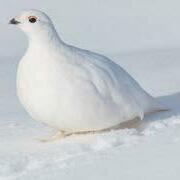
The ptarmigan (pronounced tar-migan) is the only bird in the world that changes its plumage to a winter white. Large flocks huddle together on the rocky slopes of mountains in North America, Asia and Europe (including the Highlands of Scotland).
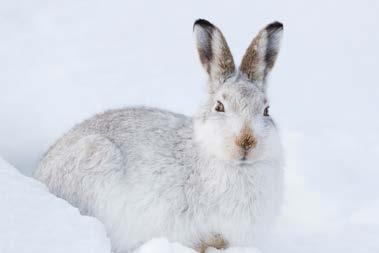
This small hare lives on the mountains and moors of central Asia and northern Europe, including Scotland and the north of England. Its grey and brown coat becomes white in winter, except for the ends of its ears, which stay black!

Stoats live in northern parts of Europe, Asia and North America. In colder areas, they turn stoat ally white during
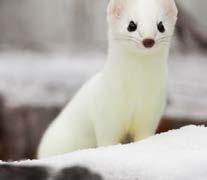
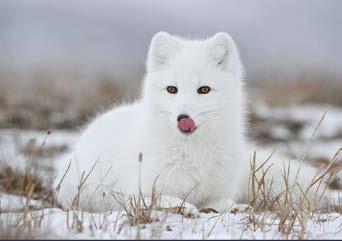
This fox is found further north than any other. The Arctic fox lives in remote regions of Canada, the USA, Russia and Scandinavia, and on the islands of Iceland and Greenland. Its brownish-grey fur becomes thicker and whiter in winter.
Why do these animals turn white in winter?
Becoming white in winter enables animals to hide away in snow-covered habitats. This helps smaller species – like mountain hares and ptarmigans – to avoid predators. But it also makes it easier
© Naturefor predators – like stoats and Arctic foxes – to sneak up on their prey without being spotted!

Scientists think that a white coat might also be warmer than a coloured one. White hairs have no pigment in them, which means there’s more room for air. This trapped air provides extra insulation – useful for when the winter temperature drops to way below zero!
How do animals turn white in winter?
Surprisingly, animals don’t put on their white winter coats when the days become colder. Instead, it happens when days become shorter (when there are fewer hours of daylight). The eyes of some animals sense this seasonal change and send a message to their brains, telling them to start replacing coloured hairs (or feathers) with white ones. Sensational!
Being white only makes sense if there’s snow around! Climate change is causing warmer winters where these animals live. This reduces the period of snow-cover (the length of time that the ground is covered by snow), with the snow arriving later and melting earlier, or even not falling at all!
Snowshoe hare coat turning white for winter!
What can these animals do to deal with our changing climate? Are they able to turn white later in winter and change back to brown earlier? Can they stop changing colour altogether?
Scientists have been studying snowshoe hares in North America. They have found that, in places where there is less snow than there used to be, some hares are not growing a white coat any more.

Whether other animals can adapt quickly enough to cope with climate change remains to be seen. In the meantime, these extraordinary creatures will be dreaming of a white Christmas this winter.
Other animals that turn white in winter include the weasel, Siberian hamster, Peary caribou and northern collared lemming.
Some animals are turning white in a world that’s no longer doing the same. This means that they are less camouflaged. Prey animals stand out against the snowless background and predators are more likely to be noticed by the prey they are hunting. Bad news for both!
Insulation: Material that keeps something warm.
Pigment: Substance that gives something its colour.
Plumage: A bird’s feathers.
© Donald M. Jones/naturepl.com © blickwinkel/AlamyIn the cold winter months, have you noticed that lots of creatures seem to disappear? What happens to them? Do they die? Are they hiding?
No, they’re HIBERNATING! Let’s find out more…
Birds and mammals need to keep a steady high body temperature. Our metabolisms have to work harder at this in the winter because it’s colder. So, some creatures go into a deep sleep state over winter, rather than wasting energy looking for food. Their body temperature drops, their breathing slows down, and they live off stored fat.
Hibernating animals don’t eat until the spring, when they wake up VERY hungry.
Torpor is deeper than normal sleep BUT not as deep as hibernation.
Animals can wake up from torpor more easily. Torpor is not as long as hibernation.
Let’s see how three different animal species HIBERNATE…
Most bumblebee species hibernate for at least six months each year, from October to March.

Only the new queens hibernate to survive through the winter. The rest of the colony – old queens, workers and males – all die as summer ends. The new queens mate in late summer, then gorge on pollen and nectar. These are stored as fat to see them through hibernation. When they wake up in spring, they produce the next generation of worker bumbles.
The queen bee’s body produces a natural anti-freeze to prevent ice crystals forming if the temperature falls too low. Ice would burst the bee’s body and kill it.
Queen bees dig into (usually) northfacing, well-drained banks of soil (to avoid
Bumblebee waking up after hibernationflooding). North-facing means the sun won’t wake bees too early.
10cm underground in a hole, bees can survive temperatures as low as -19°C!
• If spring arrives late, queens wake late and are late producing new workers. This can lead to a population drop
• Unless bees reach the correct weight, they won’t survive hibernation.
• Spring gardeners might accidentally wake sleeping bumbles.
If a disturbed bumblebee looks too active to go back to sleep, make it a little shelter out of leaf litter.
A hibernation lasting for nine months is the longest part of a queen’s life.
People often think of bears as classic hibernators. And it’s true that some species can sleep for more than 100 days without eating, drinking or pooping.
But ‘hibernating’ bears are actually in a state of torpor. That means females can wake up to care for their cubs or even give birth. They can wake up quickly, alert enough to defend their young.

Everything depends on the climate where the bears live. If food is plentiful and the weather mild, bears don’t need to hibernate at all.
Bears must prepare! Bears can lose 20% (or more) of their body fat during hibernation, so they must megamunch to increase their body mass.
Bears might make a cosy den themselves, or find a cave or hollow tree. They then fill their perfect spot with leaves and branches to keep them warm.
• Changing weather patterns can bring bears out of hibernation earlier. If there’s not enough food yet, bears will starve or become sick more easily.
• Sleeping bears are vulnerable to poachers. (Who could imagine shooting a hibernating mother bear and her cubs? But this does happen…)
European hedgehog in the snow, waking up during hibernation
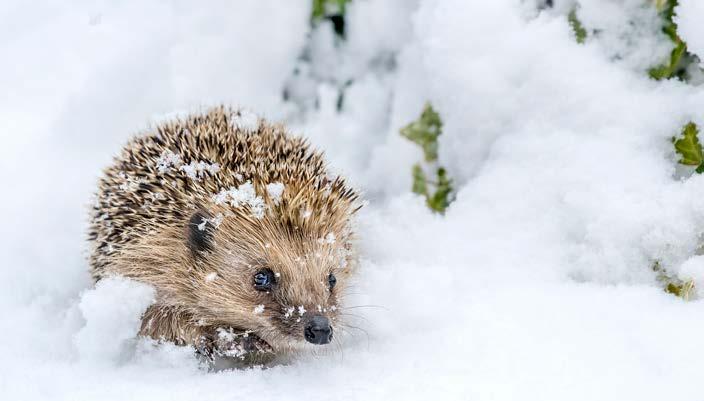
Hedgehogs usually hibernate from October or November through to March or April.
You might still spot them out and about during this period because they often move to a new nesting site.
A hedgehog’s fuel supply comes from the fat stores it has built up over the summer. It needs to weigh around 600g. Lighter hedgehogs may never wake up…
A hibernaculum is a safe place to stay during the winter. Hedgehogs build their hibernaculum out of leaves, twigs and plant materials. The nests are waterproof and well insulated, keeping a good temperature for torpor.
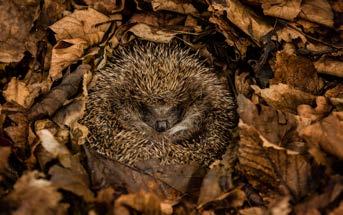
In colder parts of Europe, hedgehogs dig a hibernaculum underground for better frost protection.
• Hedgehogs can lose a third of their body weight during their long winter sleep, so they must have a large enough store of fat to see them through.
• If hedgehogs lose their first litter due to bad weather conditions, new hoglets might not have enough time to build up the fat they need to hibernate.
If you disturb a hedgehog hibernaculum by accident, cover it with a thick layer of leaves. Put some dog food and water close by in case the hedgehog needs energy to build a new nest.
Gorge: To eat excessively, to stuff yourself.
Hibernaculum: A shelter where an animal stays during hibernation. Hoglet: A baby hedgehog. Metabolism: The chemical process of converting food into energy to stay alive.

Brown: Colour in the wings on both sides, the thin strip at the bottom of the robin’s body, the top of its head, and the robin’s feather templates 1 and 2 on both sides.
Grey: Colour in the robin’s tummy.
Red: Colour in its head and chest, and the separate chest template on both sides.
Black: Colour in the eyes, outline the feathers if you like, and colour in the beak on both sides.
Key: glue spot/area cut lines
attach to area mountain fold valley fold
Key: Glue spot/area Cut lines Attach to area Mountain fold Valley fold
1. Cut out the robin’s body and wings template on pages 17-18 and colour in.
2. Cut out the robin’s chest template on page 19 and colour in. Stick on to the robin’s body where marked.
3. Cut out the beak on page 19 and colour in on both sides. Stick on to the robin’s face where marked. When sticking down, make sure the small tab is hidden underneath the beak.

4. Cut out all of the robin’s feather templates on page 19, and colour in on both sides. Match them up to the feather outlines on the front of the robin’s wings. Make sure you stick the feather templates 1 over the top of the feather templates 2. Once stuck down, use your fingers to gently curl the tips of the feathers.
5. Cut out both snowflake templates and the stars, too. You can colour these in if you like or keep them white. Stick these on to the robin’s body and wings as you like.
6. Finally, don’t forget to write a message on your robin’s red chest before giving him to friends or family.
Snow ake template
Attach robin’s red chest template here
Robin’s body & wings template Snow ake template 17
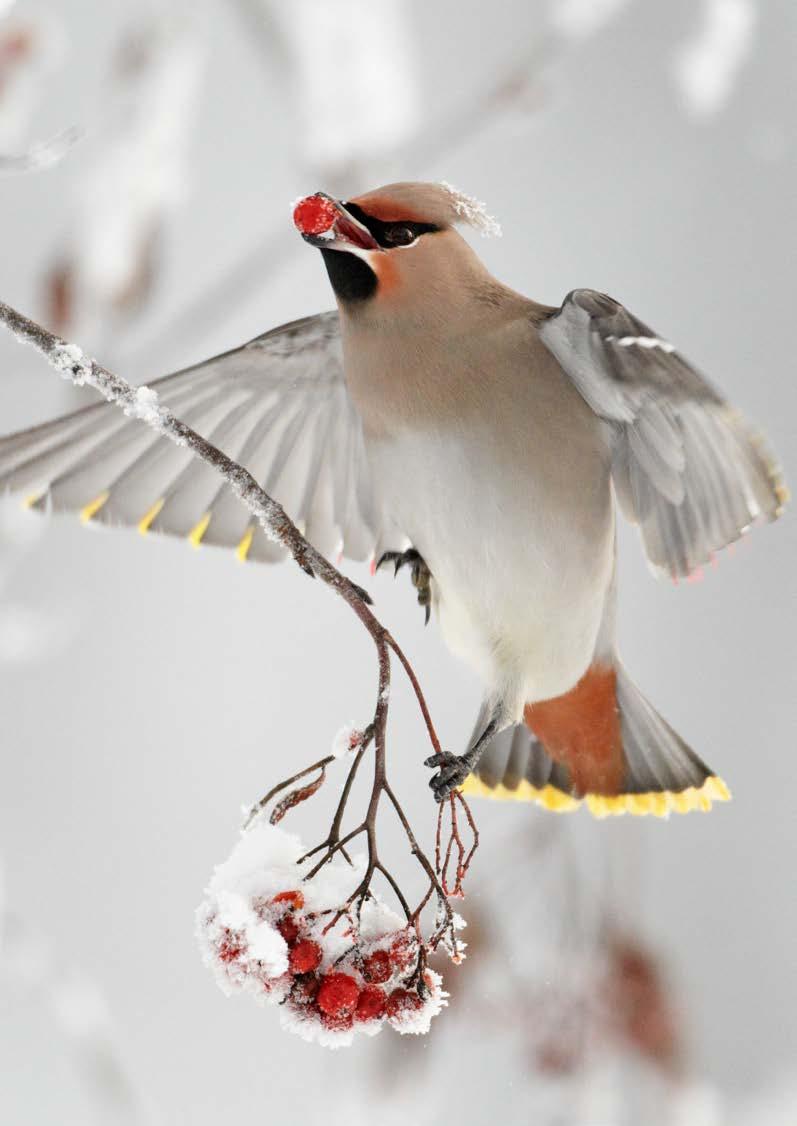
Hello, Eco Kids, Amy here!
Winter is a great time for birdwatching, because so many beautiful birds arrive here from colder countries to take advantage of our milder winter!
But winter is still a tough time for birds and their survival skills are tested to the MAX.
Everything revolves around FOOD…

• The ground is hard, making it tricky for birds to get at worms. Lots of insects hibernate and grubs are buried in the ground.
• Days are shorter, meaning there’s less time to find food before it gets dark.
• The cold weather means birds burn more calories keeping warm. So they need to eat more food.

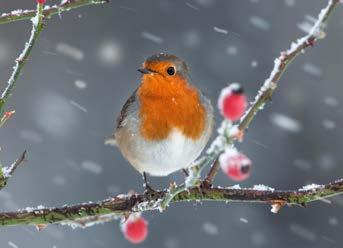
The little robin redbreast is Britain’s most recognised bird. It lives all over the country, in woodland, hedgerows, parks and gardens.
The birds can lose 10% of their body weight in just ONE COLD NIGHT. Unless they make up the loss by finding plenty of
• Some broaden their diet. For example, fieldfares eat more berries instead of insects.
• Others, like goldcrests, live as close as possible to their food source.
• They FLOCK together to find food AND keep warm at night.
• Being in a group also means safety in numbers – more beady eyes to spot predators!
food the following day, they won’t survive more than a few days.
Almost three-quarters of UK robins die before they reach one year old.
But robins are surprisingly TOUGH and TERRITORIAL little birds!
They sing throughout the year, including winter. But their songs aren’t simply a pretty tune – they are the robin fiercely defending its patch! Which is why you’ll only ever see one male robin per garden. (Males have brighter red breasts than females.)
Want to reveal the robin in YOUR garden?
Dig up enough soil to uncover a few worms, and your robin will appear to gobble up his favourite food!
People couldn’t work out how the tiny goldcrest reached these shores. Legends tell of them travelling on the backs of larger birds, such as woodcocks or short-eared owls. I’m not sure… What do you think?

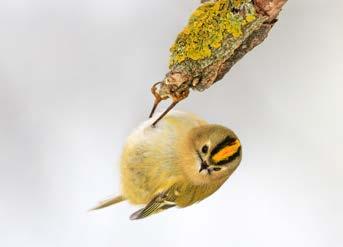
The gorgeous goldcrest weighs a minuscule 5g – that’s the same as a fivepence piece!
They are one of the LIGHTEST birds to migrate. Flying over from northern Europe, they often need to rest midway on oil rigs or fishing boats.
In order to survive the lean winter months, they live in coniferous woodlands. They spend their days feeding on the weeny insects and spiders living in the pine trees, never having to fly far for their food source.
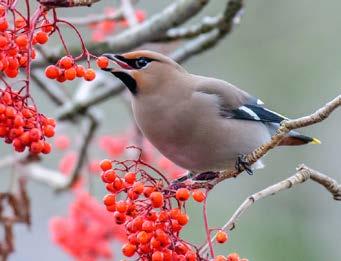
It’s all about the feasting for these winter visitors.
Waxwings leave Scandinavia and Russia in October and stay here until March. They come in search of the rich berry pickings of the UK, particularly RED berries. And we have plenty – juicy rose hips, pyracantha and hawthorn, but their absolute favourite are ROWAN tree
berries. They can strip a tree or bush bare in a few days!
I love these little birds. They are fearless and friendly, and even have a song that sounds like sleigh bells –how Christmassy!
Large numbers of waxwings appear in the UK every eight years or so. These are called irruptions and can range from a few hundred birds to tens of thousands! It all depends on the food supply in their breeding grounds.
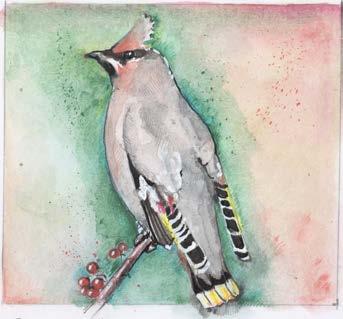
northern England, the Pennines and Scotland, before flying back in the spring. WINTER is the best time to spot them!
Short-eared owls like marshes and wetlands, and luckily for keen birdwatchers like me, they sometimes hunt during the day in winter.
They don’t like woodland and usually roost on the ground (sounds a bit chilly!).
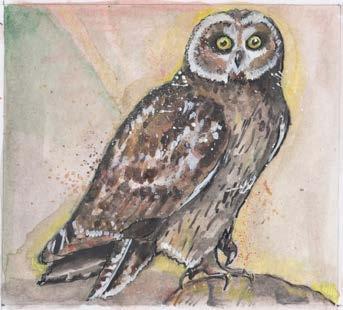

–stunning black-circled, bright yellow-eyed birds!
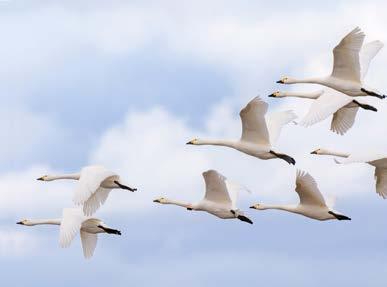
We have a native population of shorteared owls in the UK but, every winter, more arrive from Scandinavia, Russia and Iceland. They settle in north Wales,
These rare swans live in Siberia and migrate here to spend winter in east England and the Severn Estuary. The Bewick’s swan’s migration route covers 3,500km – a long and dangerous
© Nature Picture Library/ Alamy Stock Photojourney. Imagine how tired and hungry the birds are when they arrive! They eat whatever they can get their beaks on, including leftover crops, like potatoes and grain.

Bewick’s swan numbers have dropped by a third in recent years. They are shot by hunters because they look like geese. The swans also sometimes eat LEAD ammunition, which poisons and can even kill them.
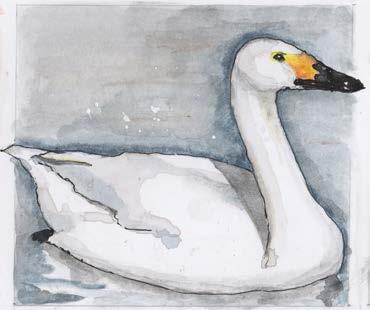
But there’s a collaboration with people from the Russian Arctic, and ‘swan champions’ are now tackling the illegal hunting!
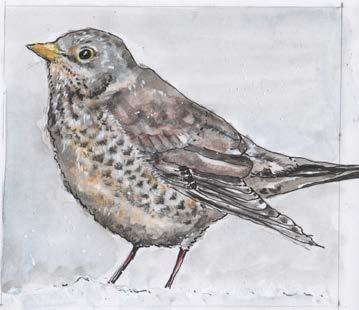


Up to 750,000 fieldfares migrate to the UK for winter every year. From midSeptember, they arrive in Scotland, and you’ll find them in southern England from mid-October. These chatty, perky birds are part of the thrush family.
Towards dusk, fieldfares gather together to roost. Once they have chosen their tree or bush, they all face in the same direction to sleep!
I want our winter visitors to feel at home, so I make sure there’s always a full (and squirrel-proof) bird feeder in the garden.
If you don’t have a bird feeder, put out some bird-friendly snacks.
Fatty foods are best for energy:
• Unsalted, uncooked bacon rind and chopped roast potatoes;
• Chopped fresh and dried fruit, cheese nibbles, biscuit or cake crumbs.
NB Refresh food daily and don’t put too much out – you don’t want to attract rats or foxes!
Now, how many winter birds can you spot?
Jolly they may be but they are also fierce defenders of their winter diet of FRUIT!Winter is when wildlife gets weird! I’ll prove it…
What's this brown ice cube? It's a deep-frozen frog!
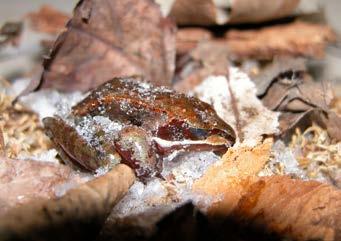
When it gets super-cold in Alaska, wood frogs have the weirdest way of coping with it. They freeze themselves into hibernation for months at a time! Twothirds of the water in their bodies turns to ice. Their hearts stop beating and their blood stops flowing. When it’s spring, the frozen-solid frogs thaw out and their hearts go back into action again!
Arctic ground squirrels have a similar skill. You’ll find them in Alaska, Canada and Siberia. When they hibernate, their body temperature drops below the freezing point of water. It’s the lowest body temperature ever recorded in a mammal – but their blood stays liquid!

Have you ever wondered how fish survive when lakes and rivers freeze over in winter? Well, only the upper layer of water freezes. Below that solid surface, the water is still liquid, so the fish are fine. They’re coldblooded, which means their body temperature matches their surroundings.

The bird that acts like a bear
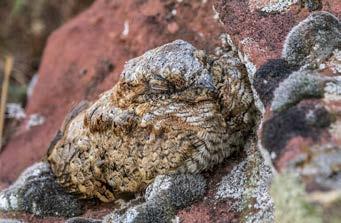
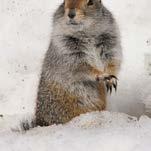
The common poorwill, a bird that lives in North America, hides under stones or logs for the winter. Well, it’s easier than migrating! We don’t know of any other bird that hibernates.
Even weirder, some butterflies hibernate directly beneath the snow. It’s actually quite warm under there!
Some other creatures are just as keen on snow…
©Paulo Olive ira / A l otohPkcotSyma © J. M.Ruffed grouse dive-bomb head-first into it! These ground-dwelling birds become snow-dwelling birds in winter. They bury themselves under fluffy snow, hollowing out a small ‘igloo’, where their body heat keeps them warm. Imagine walking through the snow in North America and a startled grouse bursting out of it in front of you!

Many birds dislike the cold and migrate to warmer countries to avoid it. Dusky grouse do the opposite – they migrate to colder places with heavy snow! These North American birds choose to fly high in the mountains, where life is much harsher.
Should I send Charlie to tell them how to migrate properly – or do they have a good reason for it? Maybe it’s because there’s not so much competition for food up there.
Common shrews shrink their skulls and brains in winter! It could be to save energy.
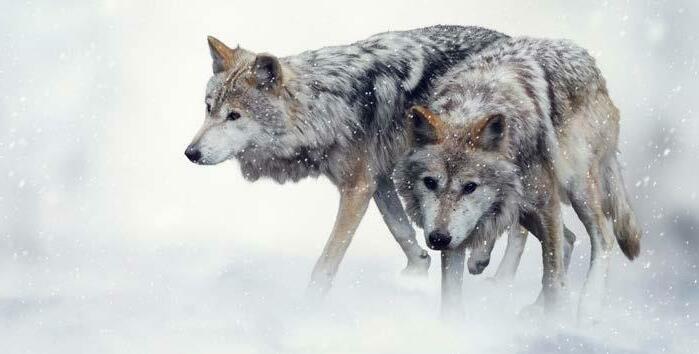
Imagine wolves having a fridgefreezer to keep their dinners in. Well, cold-climate wolves do! Not only does deep snow make it harder for their prey to escape, but it also keeps their kills fresh for months. I bet they wolf it down!
I wondered how animals hibernate through the winter without weeing or pooing – or if they do, then wake up in a mess. I discovered that some animals wake up weekly or monthly if they need to go, but not bears. Bears even recycle their wee when they hibernate! It breaks down in their bodies to form proteins that keep them healthy during that long sleep. And they can go for months without drinking any water – they extract it from their body fat!
© Svetlana Foote/AlamyWe all know that slugs and snails ooze slime. It helps them to stick to stuff and climb tricky surfaces. But slime is about 96% water, so won’t it freeze in winter? Sounds like a sticky situation!
In fact, snails use a wall of slime to protect themselves from the cold. They find somewhere to hibernate – maybe in deep leaf litter or a cosy hole in a wall –then they create a dried lid of slime over the opening of their shell. It seals them in and keeps them warm through the winter months!
Slugs don’t have shells to hide in and can freeze in winter. Many types hibernate, burying deep underground or under the loose bark of a rotting log or dying tree. But even if every single slug died in the cold, it still wouldn’t mean the end of slugs. Can you guess why? Answer below. Speaking of slime, do you know how warms keep worm – er, I mean worms keep warm? They hibernate in a shell of slime! They bury themselves deep in the soil, curl up and cover themselves with enough goo to keep out the cold.
So, slime can keep you warm – but I’ll stick to winter coats, thanks!
Common snails, snug together on a tree trunk Slug eggs
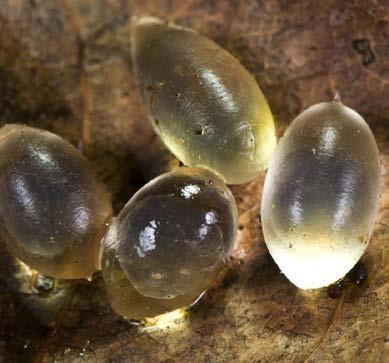

new slugs hatch from them in spring, when it’s warm again. Well planned, slugs!
They lay their eggs in autumn, and the
Some slugs do have shells – inside their bodies!
People believed some really weird things in the past. Especially about the plants we associate with winter and Christmas…
Some believed that bringing holly into your house protected you from nasty fairies! Others thought it made a nice shelter for any friendly elves and fairies already living there. And if you placed it around your door or windows, its prickles would catch any evil spirits trying to get in!
Fairy-Foiling Foliage – mistletoe!

Some people made sure to leave holly running along the tops of hedges. Why? To stop witches whizzing over them on their broomsticks, of course! Some even believed that holly bushes protected your home from lightning.

In Celtic myths, the giant Holly King stalked the land in winter after defeating his brother, the Oak King. His weapon was a big holly bush!
Some people used to hang mistletoe over their baby’s cradle. They believed it stopped fairies swapping the baby with one of their own!
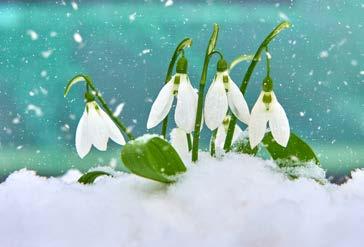
You know snowdrops, those cute little white flowers? They don’t exactly give you the creeps, do they? Yet many Victorians didn’t dare pick them for their homes. They thought the flowers brought bad luck – or even death!
But why?
The Victorians often planted snowdrops in graveyards and around graves. You still find lots of them growing in graveyards today. I bet that’s why they connected the flowers with death. Snowdrops were also said to turn your milk sour and change the colour of your butter if you brought them home!
Yes, there’s plenty of weirdness in winter – and I love it!

Across
2. The state of reduced activity during winter
3. ‘Death’s flower’
7. Which bird is famous for its stunning murmuration events? 8. Worms keep warm by hibernating in a shell of ______________ 9. A bird’s feathers
Down
1. This tiny bird weighs the same as a five-pence coin 4. Voted the UK’s national bird 5. A baby hedgehog
6. This bird can gobble up to 1,000 berries in a day!
All but one of the animals listed below have been hiding in this hibernaculum word search. Can you find them? Search up, down, forwards, backwards and diagonally to find the hidden words.
Which one of these animals doesn’t hibernate?
Fish are cold-blooded, which means their body temperature stays cold throughout the year.
Bears can go for months without drinking any water!
Animals turn their coats white when they sense that the days have become colder.
Colour
hibernate
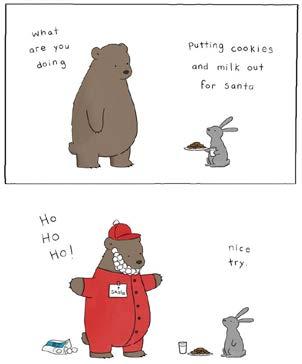
The greatest thing about autumn? All the beautiful colours! It's also a very exciting time to see lots of animals out and about making their winter preparations. For our ‘Underground Life’ issue, we encouraged you to go outside and get snapping with a camera. We’ve got to admit, our readers have a great eye for photography. Look at these super shots!
Congratulations to our five winners!
Eben, age 6, St. Bees
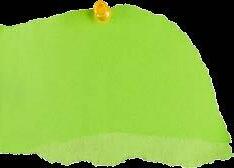

Lara, age 9, Maybole



Tiarnan, age 7, Seascale
Isaac, age 8, Leigh on Sea
Sage, age 5, London

And a big well done to our runners-up for their wonderful photos, too!
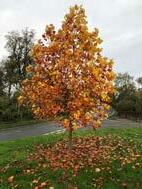


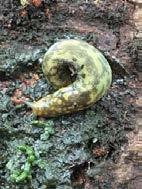
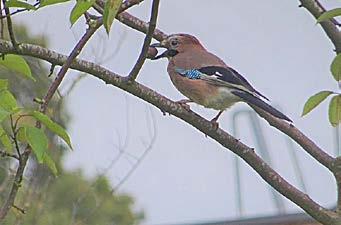
Uilliam, age 11, County Down
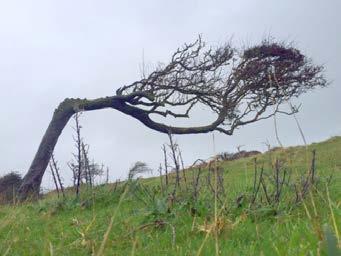
Daniel, age 6, Cork, Ireland
& Jake, Needham Market
Dalila, age 7, Croydon
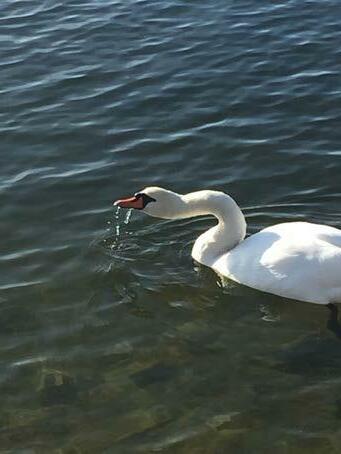
Liven up your garden with wild visitors! Here’s how to attract wildlife into your garden and help it survive through the winter.
When temperatures are freezing, a lot of water sources ice up. This makes it difficult for wildlife to have a drink. Toxic gases can also build up in a frozen pond, and these are very harmful to hibernating frogs. If your pond freezes, pop the kettle on and fill a saucepan with hot water. Place this on your pond until a hole has melted that’s big enough to allow wildlife to enter and exit. Never smash or break the ice, because this sends shockwaves into the water, which can harm wildlife.
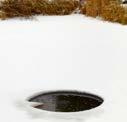


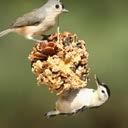

Give your bird feeders and birdbaths a good clean out with a brush, hot water and eco-friendly disinfectant. Empty out any old nesting material from nesting boxes. This helps stop diseases from spreading, keeping birds healthy over winter.
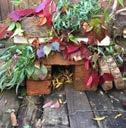
Collect fallen leaves and place them underneath hedges and shrubs, or pile them up in a quiet area of your garden. This can provide

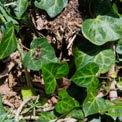
a safe home for hedgehogs, and attract important insects for hedgehogs, frogs and birds to munch on!
If you want to build something more appealing to hedgehogs, give our recycled hoggy home a go. Hedgehogs usually hibernate from now through to March/April, so now is a great time to prepare them a cosy, safe home. Don’t forget to leave a hole or gap in your fence or gate to allow your hedgehog to get in and out! https://www.ecokidsplanet. co.uk/blogs/news/how-to-build-arecycled-hedgehog-home
Don’t worry about cutting back or pulling up ivy plants. Garden mess and flowers are loved by many insects over winter, because they act as important sources of pollen. Ivy flowers over the colder months, so is a vital food source for them.
Nuts, berries, seeds and grubs are getting harder for our feathered friends to find. Top up your feeders with sustainablysourced bird seeds, dried mealworms or wax worms, or try making our pinecone bird feeders at: https:// www.ecokidsplanet.co.uk/blogs/news/ pine-cone-bird-feeder
Hedgehogs, dormice and foxes will appreciate fresh water and food being put out. You could use dog or cat food (not fish-based), sunflower seeds and nuts. Please don’t give them milk and bread, though, because it can cause diarrhoea and dehydration. If you have any fruit-bearing trees in the garden, leave fallen apples and pears for woodpeckers, foxes and badgers. Badgers love unsalted peanuts, too!
Bakers and master chefs, get your mixing bowls out and oven mitts ready! We’re challenging you to create some delicious animal creations. Will you make polar bear cupcakes? Penguin pizzas? Piggy pastries? The options are endless! A great way to make some homemade Christmas gifts, too! FIVE lucky readers will win one of our brand new Eco Kids Planet magazine binders.



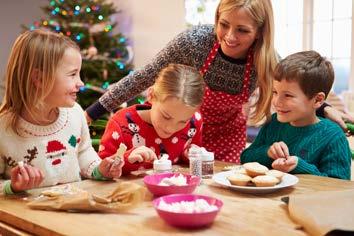

What to do: Send us a photo of your creation. We welcome recipes, too! Available at: www.ecokidsplanet.co.uk/products/eco-kids-planet-binder
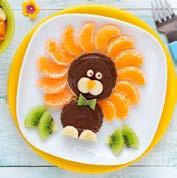
How to submit your entries: Send a photo of your creation to Eco Kids Planet, 41 Claremont Road, Barnet, EN4 0HR or email win@ecokidsplanet.co.uk before 10th January 2020. Please make sure you include your full name, age and address, so we know how to reach you.

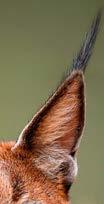
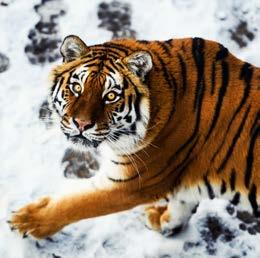
Wild Cats of the Past
The sabre-toothed cats, cave lions and other mysterious species
Charlie Meets a Sand Cat Britain's Mystery Big Cats
What are they and how did they get here?

Wild Cat Superpowers Discover their extraordinary skills
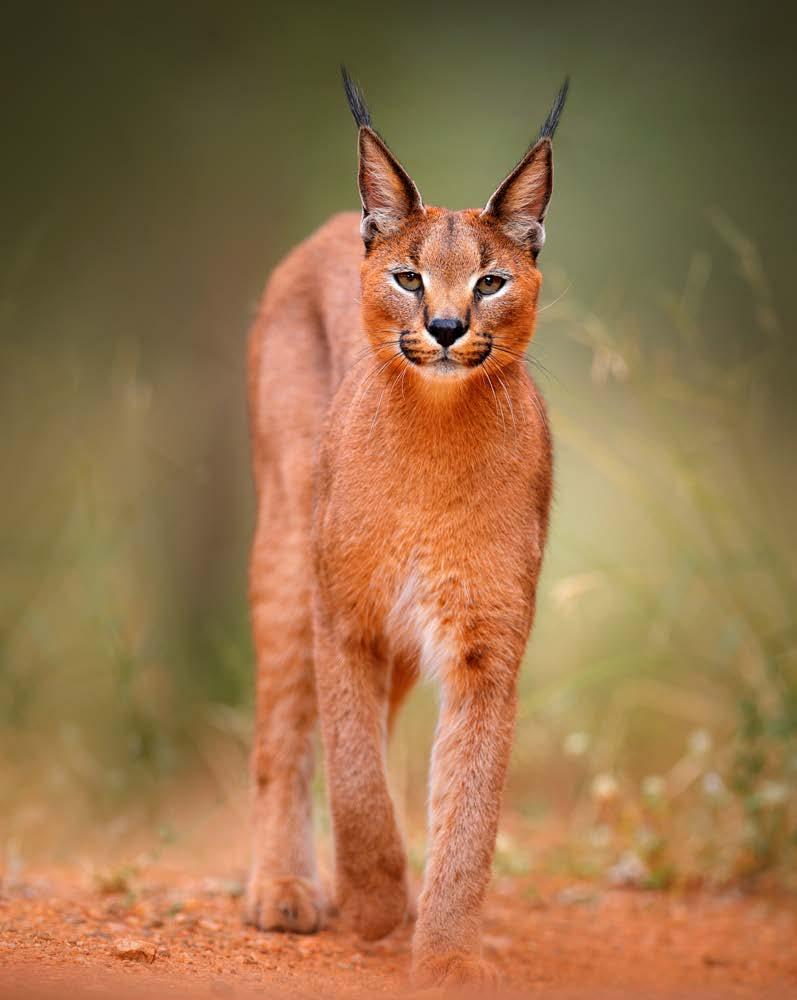
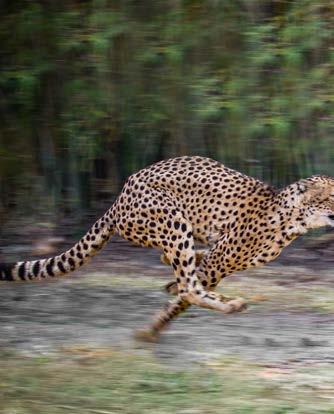

Issue 63 ecokidsplanet.co.uk
Success stories and the work that must still be done
Why are leopards spotted? Why are tigers striped?